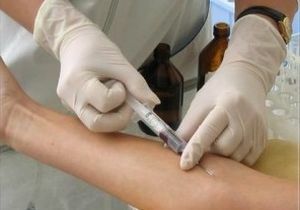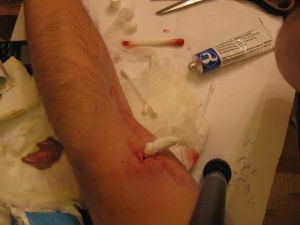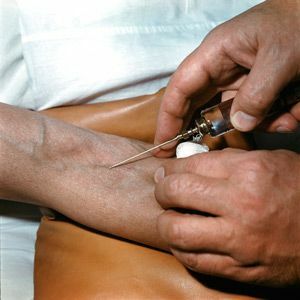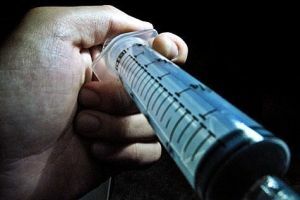 Postinjection phlebitis is the inflammatory process of the vessel walls of , which occurs due to intravenous intervention with the introduction of irritant substances into the vessel, followed by the appearance of thrombi.
Postinjection phlebitis is the inflammatory process of the vessel walls of , which occurs due to intravenous intervention with the introduction of irritant substances into the vessel, followed by the appearance of thrombi.
A distinctive feature of phlebitis is the presence of a lumen in the vessel.
Contents
- Causes of the disease
Causes of the disease
- Symptoms and signs of the disease
- Diagnostic techniques
- Treatment of the disease
- Possible complications
- Prevention
- Conclusions
Causes of the disease
The main cause of the disease is the patient's catheterization, against a background of low immunity, infectious diseases and immobilized condition.
Injury to the with nerve endings in the vessel wall leads to regular spastic contractions of the veins.
Increased platelet production, which slows down the blood flow, which causes an even more severe spasm.
A large percentage of patients with this diagnosis are drug addicts who regularly perform intravenous injections. Lack of sanitary norms, the possible presence of HIV infection, a large diameter of the needle: all this can lead to particularly severe forms.Symptomatology and signs of the disease
Postinjectional phlebitis has characteristic symptoms and the main symptom is an increase in the diseased vein in diameter, its color change( reddening or blueing) and protrusion. The first stage of the development of the disease is accompanied by pain and severe hyperemia.
loading. ..In the absence of treatment, thrombophlebitis begins to progress. The patient raises the temperature to 39 degrees, axillary and elbow
 lymph nodes increase.
lymph nodes increase. Because the disease is often accompanied by withdrawal syndrome , there are symptoms such as: patient's anxiety, complaints of severe pain, and some other mental conditions interfering with an accurate diagnosis.
In consequence, there is a strong reddening of the skin, an increase in the affected limb in half, muscle tension. After three to five days, the tissues become soft, the fluctuation begins.
Diagnostic Techniques
First of all, the doctor conducts palpation of a sick vein. Perhaps the detection of infiltration, which indicates the spread of inflammation on the vast area of subcutaneous tissue.
Urine and blood tests are also prescribed, if necessary, an X-ray, ultrasound.
The doctor must have a complete history of the patient, for a more rapid and accurate diagnosis and timely treatment.
 An important study of the vessels of the lower extremities is reovasography - how the procedure goes and who is appointed.
An important study of the vessels of the lower extremities is reovasography - how the procedure goes and who is appointed. Striping is a mini-invasive method of treating a disease. Details of the procedure, preparation and rehabilitation are described in detail here.
Treatment of
If a post-injection phlebitis is diagnosed in the patient, conservative treatment of is used in the initial stages.
It includes the use of anticoagulants, local dressings containing silver preparations, antibacterial therapy and the use of anti-inflammatory drugs( ibuprofen, nimesil, etc.).
Depending on the degree of the disease, a multifaceted treatment is carried out: the relief of pain and inflammatory syndrome, the stabilization of the muscles of the veins, the regulation of blood flow and the blood-clotting system, antibiotic therapy, with infection, the elimination of spasms and the causes of phlebitis.
For an increased concentration of the drug in the affected area, they are injected into the body endolymphatically.
During treatment, all kinds of physiotherapy are contraindicated so that purulent inflammation does not start. The very same treatment is carried out exclusively permanently because of the increased likelihood of thromboembolism and phlegmon.With the development of purulent inflammation, surgical treatment is necessary. A purulent focus is opened and the excision of the edges of the wound is performed. Also, the need for surgical intervention arises in acute complications.
Possible complications of
 Often, complications occur when there is no timely treatment or self-medication. At the last, the probability is high, it is not just to inflict enormous harm on your health, but also to get a fatal outcome.
Often, complications occur when there is no timely treatment or self-medication. At the last, the probability is high, it is not just to inflict enormous harm on your health, but also to get a fatal outcome. Usually acute phlebitis with proper treatment does not pose a threat to a person. Nevertheless, there is a chronic course of the disease with sluggish symptoms, which can be ignored and treated by folk remedies.
Then spontaneous aggravation can lead to serious consequences. Also, chronic phlebitis threatens the development of hepatic insufficiency.
Our readers recommend!For the treatment and prevention of varicose veins and hemorrhoids, our readers use the method first voiced by Malysheva. Having carefully studied it, we decided to offer it to your attention. Opinion of doctors. .. "Those who suffered phlebitis, should adjust their lifestyle :
- to conduct walking tours;
- does not overstrain the leg muscles;
- to stop smoking and taking alcohol;
- Avoid all factors leading to spasms.
Prevention of
To avoid the possible emergence of phlebitis, hormonal contraceptives should be abandoned, in particular, with a tendency to vascular diseases.
It is recommended that behave in a healthy way: should not smoke, do not consume alcohol-containing foods, and foods high in cholesterol.
Special physical exercises: walking, squats, gymnastics, also play an important role in the prevention of phlebitis.
During long-term treatment with the use of droppers( catheters) and injections( needles), it is necessary to lubricate regularly with special ointments, for example with horse chestnut.
In case of suspicion of phlebitis, it is necessary to consult a doctor immediately, since it is not known when a blood clot in the vessel may form and come off, thus causing instant death.
Conclusions
Unfortunately, this disease is very common. Sometimes it can not be prevented and cured in time.

Every year, in the world, thousands of people die, who did not have time to receive correct and timely treatment. All of them became victims of spontaneous tearing of the blood clot and getting it, first, into the right atrium, and then to the right ventricle, with subsequent exposure to a small circle of circulation and lungs.
Some people die during injection phlebitis not because of thrombophlebitis, but because of infection in the vein that is inflamed and opened by the needle.Such cases often occur in drug addicts who periodically inject drugs into their arms or legs without worrying about the sterility of the procedure.
loading. ..
